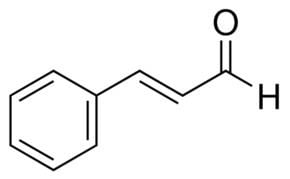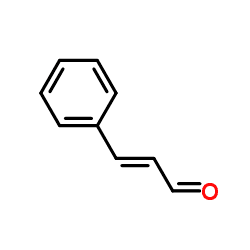Related compounds Molar mass 132.16 g/mol Boiling point 248 °C Appearance Yellow oil | Formula C9H8O Density 1.05 g/cm³ Melting point -7.5 °C | |
 | ||
Cooking with chemicals cinnamaldehyde
Cinnamaldehyde is an organic compound with the formula C6H5CH=CHCHO. Occurring naturally as predominately the trans (E) isomer, it gives cinnamon its flavor and odor. It is a flavonoid that is naturally synthesized by the shikimate pathway. This pale yellow, viscous liquid occurs in the bark of cinnamon trees and other species of the genus Cinnamomum. The essential oil of cinnamon bark is about 50% cinnamaldehyde.
Contents
- Cooking with chemicals cinnamaldehyde
- How to make the cinnamaldehyde clock
- Structure and synthesis
- Biosynthesis
- Synthesis
- Metabolism
- As a flavorant
- As an agrichemical
- Miscellaneous uses
- Derivatives of cinnamaldehyde
- Toxicology
- References

How to make the cinnamaldehyde clock
Structure and synthesis

Cinnamaldehyde was isolated from cinnamon essential oil in 1834 by Dumas and Péligot and synthesized in the laboratory by the Italian chemist Luigi Chiozza (1828-1889) in 1854.

The natural product is trans-cinnamaldehyde. The molecule consists of a benzene ring attached to an unsaturated aldehyde. As such, the molecule can be viewed as a derivative of acrolein. Its color is due to the π → π* transition: increased conjugation in comparison with acrolein shifts this band towards the visible.
Biosynthesis

The biosynthesis of cinnamaldehyde begins with deamination of L-phenylalalanine into cinnamic acid by the action of phenylalanine ammonia lyase (PAL). PAL catalyzes this reaction by a non-oxidative deamination. This deamination relies on the MIO prosthetic group of PAL. PAL gives rise to trans-cinnamic acid.

In the second step, 4-coumarate: CoA ligase (4CL) converts cinnamic acid to cinnamoyl-CoA by an acid-thiol ligation. 4CL uses ATP to catalyze the formation of cinnamoyl-CoA. 4CL effects this reaction in two steps. 4CL forms a hydroxycinnamate-AMP anhydride, followed by a nucleophile attack on the carbonyl of the acyl adenylate.
Cinnamoyl-CoA is reduced by NADPH catalyzed by CCR (cinnamoyl-CoA reductase) to form cinnamaldehyde.
Synthesis
Several methods of laboratory synthesis exist, but cinnamaldehyde is most economically obtained from the steam distillation of the oil of cinnamon bark. The compound can be prepared from related compounds such as cinnamyl alcohol, (the alcohol form of cinnamaldehyde), but the first synthesis from unrelated compounds was the aldol condensation of benzaldehyde and acetaldehyde.
Metabolism
Cinnamaldehyde occurs widely, and closely related compounds give rise to lignin. All such compounds are biosynthesized starting from phenylalanine, which undergoes conversion.
Cinnamoyl-CoA reductase is an enzyme responsible for the production of cinnamoyl-CoA from cinnamaldehyde.
As a flavorant
The most obvious application for cinnamaldehyde is as flavoring in chewing gum, ice cream, candy, and beverages; use levels range from 9 to 4900 parts per million (ppm) (that is, less than 0.5%). It is also used in some perfumes of natural, sweet, or fruity scents. Almond, apricot, butterscotch, and other aromas may partially employ the compound for their pleasant smells. Cinnamaldehyde can be used as a food adulterant; powdered beechnut husk aromatized with cinnamaldehyde can be marketed as powdered cinnamon. Some breakfast cereals contain as much as 187 ppm cinnamaldehyde.
As an agrichemical
Cinnamaldehyde is also used as a fungicide. Proven effective on over 40 different crops, cinnamaldehyde is typically applied to the root systems of plants. Its low toxicity and well-known properties make it ideal for agriculture. Cinnamaldehyde is an effective insecticide, and its scent is also known to repel animals, such as cats and dogs. It has been tested as a safe and effective insecticide against mosquito larvae. A concentration of 29 ppm of cinnamaldehyde kills half of Aedes aegypti mosquito larvae in 24 hours. Trans-cinnamaldehyde works as a potent fumigant and practical repellant for adult mosquitos.
Miscellaneous uses
Cinnamaldehyde is also known as a corrosion inhibitor for steel and other ferrous alloys in corrosive fluids such as hydrochloric acid. It is believed that this is achieved by polymerization to form a protective film on the metal surface. It can be used in combination with additional components such as dispersing agents, solvents and other surfactants. Cinnamaldehyde is also a potent inducer of apoptosis via ROS-mediated mitochondrial permeability transition in human promyelocytic leukemia HL-60 cells. Cinnamaldehyde also has antimicrobial properties. Cinnamaldehyde is also a TRPA1 activator, and can excite a subset of sensory neurons that are mainly cold-sensitive neurons, to cause nociceptive behavior in mice.
Derivatives of cinnamaldehyde
Numerous derivatives of cinnamaldehyde are commercially useful. Dihydrocinnamyl alcohol, which occurs naturally but is produced by double hydrogenation of cinnamaldehyde, is used to confer the fragrances of hyacinth and lilac. Cinnamyl alcohol similarly occurs naturally and has the odor of lilac, but can be also produced starting from cinnamaldehyde. Dihydrocinnamaldehyde is produced by the selective hydrogenation of the alkene subunit. α-Amyl- and α-hexylcinnamaldehyde are important commercial fragrances, but they are not prepared from cinnamaldehyde.
Toxicology
Cinnamaldehyde is used in agriculture because of its low toxicity, but it is a skin irritant.
